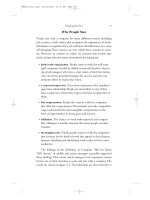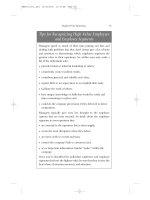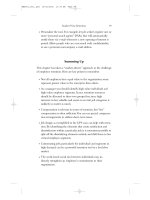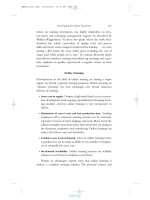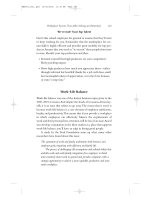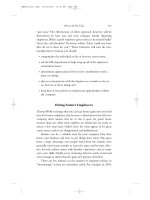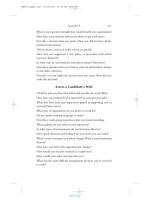Hiring and Keeping the Best People TEAM FLY.The Harvard Business Essentials docx
Bạn đang xem bản rút gọn của tài liệu. Xem và tải ngay bản đầy đủ của tài liệu tại đây (822.07 KB, 184 trang )
Hiring and
Keeping the
Best People
HBE001_fm_.qxd 10/02/2002 11:27 AM Page i
TEAMFLY
Team-Fly
®
The Harvard Business Essentials Series
The Harvard Business Essentials series is designed to provide com-
prehensive advice, personal coaching, background information, and
guidance on the most relevant topics in business. Drawing on rich
content from Harvard Business School Publishing and other
sources, these concise guides are carefully crafted to provide a highly
practical resource for readers with all levels of experience.To assure
quality and accuracy, each volume is closely reviewed by a special-
ized content advisor from a world-class business school. Whether
you are a new manager interested in expanding your skills or
an experienced executive looking for a personal resource, these
solution-oriented books offer reliable answers at your fingertips.
Other books in the series:
Finance
Managing Change and Transition
HBE001_fm_.qxd 10/02/2002 11:27 AM Page ii
HARVARD
BUSINESS
ESSENTIALS
Harvard Business School Press
|
Boston, Massachusetts
Hiring and
Keeping the
Best People
HBE001_fm_.qxd 10/02/2002 11:27 AM Page iii
Copyright 2002 Harvard Business School Publishing Corporation
All rights reserved
Printed in the United States of America
06 05 04 03 02 5 4 3 2 1
No part of this publication may be reproduced, stored in or introduced into a retrieval
system, or transmitted, in any form, or by any means (electronic, mechanical, photo-
copying, recording, or otherwise), without the prior permission of the publisher.
Requests for permission should be directed to , or
mailed to Permissions, Harvard Business School Publishing, 60 Harvard Way, Boston,
Massachusetts 02163.
Library of Congress Cataloging-in-Publication Data
Harvard business essentials. Hiring and keeping the best people.
p. cm.— (The harvard business essentials series) Includes bibliographical
references and index.
ISBN 1-57851-875-X (alk. paper)
1. Employee selection. 2. Employee retention. 3. Employee motivation. I. Title:
Hiring and keeping the best people. II. Harvard Business School. III. Series.
HF5549.5.S38 H37 2002
658.3'1—dc21
2002010627
The paper used in this publication meets the requirements of the
American National Standard for Permanence of Paper for Publications and
Documents in Libraries and Archives Z39.48–1992.
HBE001_fm_.qxd 10/02/2002 11:27 AM Page iv
Contents
Introduction xi
1 The Hiring Process 1
Attracting the Best People
Defining Job Requirements 2
Recruiting Promising Candidates 7
Interviewing 10
Evaluating the Candidates 21
Making the Decision and Offer 25
Don’t Forget Process Improvement 28
Summing Up 29
2 Beyond the Hiring Basics 31
Details You Need to Know
Online Recruiting 32
When to Use a Professional Recruiter 38
Case Interviewing 40
Hiring Based on Embedded Personal Interests 42
Hiring for Microculture 49
Psychological Testing 52
Summing Up 55
3 Keeping the Best 57
Essential Retention Strategies
Why Retention Matters 60
Why Retention Is So Challenging 66
Master Page A
HBE001_fm_.qxd 10/02/2002 11:27 AM Page v
The Special Challenges of a Diverse Work Force 69
Why People Stay 75
Why People Leave 77
Two Retention Champions 79
Managing for Retention:An Overview 81
Summing Up 85
4 Market-Wise Retention 87
Competing in the War for Talent
Not All Employees Have Equal Value 88
Market-Based Retention Strategies 92
Summing Up 99
5 Developing the Talent You Have 101
Strategies for Training and Development
The Development Dilemma 103
Skill Training 104
Career Development 108
Handling C Performers 112
Summing Up 114
6 Workplace Factors That Affect Hiring
and Retention 115
Focusing on Culture
Consider Your Culture 116
Employee Burnout 119
Work-Life Balance 123
Summing Up 133
7 When All Else Fails 135
Keeping Talented Employees, Even After They Leave
Keeping Valued People in Your Orbit 136
Hiring Former Employees 139
Exit Interviews 141
Summing Up 142
vi Contents
HBE001_fm_.qxd 10/02/2002 11:27 AM Page vi
Appendix A: Sample Job Description 143
Appendix B: Targeted Interview Questions 145
Appendix C: Legal Landmines in Hiring 151
Notes 155
Glossary 159
For Further Reading 161
Index 165
About the Subject Advisor 169
About the Writer 170
Contents vii
HBE001_fm_.qxd 10/02/2002 11:27 AM Page vii
HBE001_fm_.qxd 10/02/2002 11:27 AM Page viii
This Page Intentionally Left Blank
Hiring and
Keeping the
Best People
HBE001_fm_.qxd 10/02/2002 11:27 AM Page ix
This Page Intentionally Left Blank
Introduction
This book explains the essentials of what managers and business
owners need to know about hiring and retaining good employees.
Effective hiring and personnel retention are the two bases of future
organizational well-being. If that seems like an overstatement, con-
sider this: The success of most of today’s businesses depends more on
human assets than on physical or financial assets. Buildings, equip-
ment, manufacturing facilities, and most technologies can be readily
purchased,but the human talent and know-how needed to drive our
knowledge-based industries are much harder to come by.
Hiring decisions are among the most important decisions made
by managers, and this book explains the essentials of what managers
and business owners need to know about this process.Without the
right people in the right positions, neither a company nor its in-
dividual units can turn in exceptional performance. Good hiring
decisions create a foundation for more effective performance by
employees, teams, and the company overall. Conversely, bad hiring
decisions drag down performance and are painfully expensive to
correct. Bradford Smith, a consultant who helps major corporations
with their hiring decisions, has estimated from his study of fifty-four
U.S. companies that the average managerial “mis-hire” costs a com-
pany twenty-four times the individual’s base compensation!
1
How is
that possible? Smith points to all the usual suspects: the mis-hire’s
compensation and cost of maintenance, the initial hiring cost, sever-
ance expenses, the costs associated with hiring and training a
replacement, and so forth. But the biggest cost, according to Smith,
is the cost of the mistakes, failures, and missed business opportunities
xi
HBE001_fm_.qxd 10/02/2002 11:27 AM Page xi
TEAMFLY
Team-Fly
®
that result from having the wrong person in a management position
over several years.Thus, in his calculation, the average total cost for a
mis-hired manager with a base compensation of $114,000 will cost
a company $2.7 million in not just tangible fees, but the intangible
expenses of errors and lost opportunities.
The damage that mis-hired or mis-placed individuals can cause
is particularly acute when they are managers. C-level managers typ-
ically hire C-level players, set lower standards, and eventually create
an exodus of truly competent people.When excellent managers and
great employees are hired, the opposite prevails.Thus, hiring man-
agers have a powerful obligation to their company and to themselves
to treat hiring with the greatest attention and to be as deliberate as
possible in identifying and engaging the best possible people. David
Oglivy summed up the importance of careful hiring when he wrote,
“If each of us hires people who are smaller than we are, we shall
become a company of dwarfs. But if each of us hires people who are
bigger than we are, we shall become a company of giants.”
Retention is the other side of the human asset equation. In a
market-driven economy you’ll never be able to keep everyone—and
you shouldn’t want to.A certain amount of employee turnover can
actually improve the health of an organization, infusing new energy
and new ideas into the ranks. But turnover among valued employ-
ees is costly, disruptive, and negatively correlated with customer sat-
isfaction.As this book will reveal, hiring right is a powerful first step
in reducing unwanted turnover. But there are many other things you
can do to make your workplace one that good people will not want
to leave, and these will be addressed here in detail.
What’s Ahead
As a manager responsible for hiring decisions, this Harvard Business
Essentials volume will provide you with the basics of hiring and
retaining great people.
Chapter 1 begins with a five-step process for effective hiring,
from determining the job requirements to recruiting, interviewing,
and evaluating candidates, and making an offer.
xii Introduction
HBE001_fm_.qxd 10/02/2002 11:27 AM Page xii
Chapter 2 digs deeper into key steps of the hiring process. Using
a conceptual framework of “embedded life interests,” it will help
you align individuals with jobs that they will find most satisfying and
at which they will excel.The chapter also covers the pros and cons of
timely subjects such as online recruiting, the use of “head hunters”
and search firms, candidate testing, and the case interview technique.
In Chapter 3, we move from hiring to the field of employee
retention. Distilling recent research findings, we will explore why
retention matters—as measured by customer satisfaction, turnover
costs, and business performance. This chapter explains, in broad
strokes, why people stay with a company and why they leave, and
points to eight practical steps that managers can take to improve
retention.
Chapter 4 looks at the retention challenge from a market per-
spective. From this perspective, some employees and employee seg-
ments represent more value to the organization than others. The
market perspective suggests that managers should be less concerned
about overall turnover and more concerned with focusing retention
attention and resources on those individuals and employee segments
that create the most value for the organization.This chapter explains
how various market-based strategies can reduce turnover amongst
these key individuals and employee segments.
Training and career development are also shown to be effective
tools for the retention of valued employees. Chapter 5 describes for-
mal and informal approaches to employee training, explains why
training pays, and offers tips on reducing its costs through online
learning. In addition to boosting retention, many of your organiza-
tion’s human resource needs can be cultivated internally through
employee development—specifically, skill training and career devel-
opment—and this chapter will also address this key benefit.
The effect of the workplace environment on hiring and reten-
tion is the subject of Chapter 6.This chapter not only explains how
workplace climate can influence a candidate’s decision to take a job
and to stick with it, but also addresses how you can alter the culture
of your workplace to make it more appealing and to avoid employee
burnout. Also discussed are three principles for creating successful
work-life balance programs.
Introduction xiii
HBE001_fm_.qxd 10/02/2002 11:27 AM Page xiii
Even if you handled every aspect of hiring and retention per-
fectly, you would still lose some valued employees.This is a fact of
life in a free labor market. But as Chapter 7 reveals, the departure of
a good employee need not be the end of your productive relation-
ship with that individual.This chapter shows how some professional
service firms are using alumni relations programs to keep former
employees in their orbits as customers, sources of market intelli-
gence, and, in some cases, as future “rehires.”The benefits of rehires,
and of using exit interviews to uncover the root causes of employee
turnover, are also explored in this final chapter.
In our mission to cover the “essentials” of hiring and retention,
we’ve naturally been able to touch only lightly on many subjects and
have left others out entirely. So, for readers who would like to learn
more, a number of helpful resources are included at the end of this
book: a glossary of terms, an annotated list of relevant articles and
books, and three appendices.Appendix A contains a job description
that you can use as a model in developing your own descriptions.
Appendix B is a generic group of questions that you can use as you
interview candidates for just about any type of job. Appendix C
describes the “legal landmine” that readers based in the United
States need to be aware of, and avoid, in the hiring process.
In addition, you will find invitations throughout the book to
visit the official Harvard Business Essentials Web site, www.elearn-
ing.hbsp.org/businesstools, for free interactive versions of the tools
introduced in this book.
The content in this book is based on a number of books,articles,
and online productions of Harvard Business School Publishing, in
particular: Peter Cappelli’s Harvard Business Review article on mar-
ket-driven retention; various hiring and retention articles published
in Harvard Management Update; and the hiring module found in Har-
vard ManageMentor®, an online service.
While this book will help you improve your hiring and
employee retention skills, the information given here is of a general
nature and is not intended as legal advice nor as a substitute for legal
consultation regarding general hiring processes or the management
of specific individual situations.With that caveat in mind, let’s turn
to the five-step hiring process.
xiv Introduction
HBE001_fm_.qxd 10/02/2002 11:27 AM Page xiv
The Hiring Process
Attracting the Best People
1
Key Topics Covered in This Chapter
•
Defining job requirements
•
Recruiting promising candidates
•
Interviewing
•
Evaluating candidates
•
Making the decision and offer
HBE001_ch1_.qxd 10/03/2002 2:47 PM Page 1
L
ike many other activities undertaken by organiza-
tions, hiring is a business process—a set of activities that
turn inputs into outputs.This process compiles informa-
tion about job requirements, the applications of various candidates,
and the deliberations of decision makers, and produces an outcome:
new people on the payroll.This chapter describes a five-step hiring
process. Execute these steps well, and not only will the quality of
your hires improve, but you will also be more confident that you are
hiring the right people.
Defining Job Requirements
Before you can make a good hire, you need to know what you are
hiring for. You also need to determine which skills and personal
attributes will be a good “fit” with the requirements of the job and
the organization.
To define the job and its requirements, you need to understand:
•
the primary responsibilities and tasks involved in the job;
•
the background characteristics needed to perform the job
(education and experience);
•
the personal characteristics required (for example, does the
individual need to have strong interpersonal skills? Be highly
intelligent?);
HBE001_ch1_.qxd 10/03/2002 2:47 PM Page 2
•
the key features of your organization’s culture (for example,
team-orientation, degree of conformity, reward systems); and
•
your managerial style (for example, authoritative, coercive,
democratic) and its implications for an effective working
relationship.
Primary Responsibilities and Tasks
If you’re looking to rehire for an existing job, take a look what the
current incumbent is now doing and evaluate their job description,
if one exists. But don’t simply accept either of these perspectives as
definitive. Use the hiring opportunity to reevaluate the primary
responsibilities and tasks of the job. Make sure you can answer the
question,“What does the employee have to do in this job?”
Education and Experience
Education and experience are the two most critical background
characteristics to consider when evaluating candidates. In the case of
education, you may wish to specify a certain type of degree or a cer-
tain level. Be sure to ask yourself whether a specific educational
background is truly necessary. Can you be flexible in this area, or
can relevant experience be substituted for a certain educational
background?
Experience requirements should be based on a thorough analy-
sis of the specific tasks and responsibilities of the position. Which
would be most desirable:
•
Industry experience?
•
Functional experience?
•
Large- versus small-company experience?
Industry and functional experience are particularly important for
externally oriented positions requiring knowledge of products and
competitors. However, if a good candidate has not been exposed to
The Hiring Process 3
HBE001_ch1_.qxd 10/03/2002 2:47 PM Page 3
everything required, consider whether he or she can learn what is
needed and how long that learning will take.Various tests, for ex-
ample, are available to measure an individual’s dexterity with numer-
ical data, spatial acumen, mechanical ability, and so forth.Also, deter-
mine whether the organization can afford the time needed for
on-the-job learning.
Personal Characteristics
Personal characteristics can indicate how the candidate will ap-
proach the job and how he or she might relate to coworkers (see
“Create Consensus on Personal Characteristics”). Evaluate the
following personal characteristics relative to the tasks and responsi-
bilities you’ve listed for the job opening:
•
Analytical and creative abilities. A candidate’s abilities in these
two areas determine how he or she assesses problems and comes
up with new approaches to solving them.
•
Decision-making style. Decision-making style is very individ-
ual. Some people are extremely structured, analytical, and fact-
based; others rely more on intuition. Some make decisions
quickly, while others ponder them for a long time. Some depend
on consensus, while others seek their own counsel. It is critical
to determine whether a particular style is required for success in
the job and, if so, what it is.
•
Interpersonal skills. Since interpersonal skills and behavior are
intimately connected, understanding a candidate’s interpersonal
skills is an important part of the hiring decision process. To
determine which interpersonal skills are most appropriate for a
given position, think about the set of tasks that will be per-
formed in the position.Which traits will translate into good per-
formance, especially in view of the superiors, peers, and direct
reports with whom the person will interact? For example, a
controller should ideally be patient and formal, demonstrating
careful, cautious, detail-oriented behavior. For a sales manager,
high extroversion and low formality may be desirable.
4 Hiring and Keeping the Best People
HBE001_ch1_.qxd 10/03/2002 2:47 PM Page 4
The Hiring Process 5
• Motivation. The candidate’s personal goals, interests, energy
level, and job progression often demonstrate their level of moti-
vation. So ask yourself,“Does this job match the candidate’s per-
sonal aspirations? Would he or she do the job with enthusiasm
and energy?
Develop a Job Description
Once you understand the position’s requirements, you are ready to
create a job description. A job description is a profile of the job, its
essential functions, reporting relationships, hours, and required cre-
dentials.This description will make it possible for you to explain the
job both to potential candidates and to any recruiters you may be
using to help identify candidates. In some cases, your organization
may have a required format or a standard job description to use as a
model.
A clearly written, results-oriented job description can shape the
beginning of the employee relationship, and can help everyone
understand the mission, culture, needs, and goals of the company.
It can also form the basis of a legal termination of employment
should that become necessary.Your job description should include
the following:
• job title, business unit, and the name of the organization
• job responsibilities and tasks
• hiring manager and reporting manager
• summary of the job tasks, responsibilities, and objectives
• compensation, hours, and location
• background characteristics required
• personal characteristics required
Many of these items will have to be cleared with the human re-
source department.
Developing the job description can be an opportunity to
redesign a job, instead of just filling the one you already have. For
HBE001_ch1_.qxd 10/03/2002 2:47 PM Page 5
6 Hiring and Keeping the Best People
Many hiring decisions start off on the wrong foot because the
company hasn’t clarified exactly what it wants in the new hire.
For example, the different people with whom the new hire will
interact (or who have a say in the hiring decision) may have
their own ideas about the perfect job candidate.
Consider the hypothetical case of a company that wants to fill
a product-designer position but hasn’t reached a consensus
about key hiring factors. The design director wants a seasoned
individual who has gained extensive design experience at one of
the firm’s toughest competitors. The head of finance prefers a
bright new (and more affordable) college graduate.The market-
ing director is pressing for someone with marketing experience
in the kinds of product lines the company currently offers.
Meanwhile, the new hire’s immediate supervisor is looking for
someone with “people skills.”
Pity the poor job applicant who walks into this situation! To
avoid this type of confusion, try this procedure:
• Ask everyone who’ll interact with the new hire to privately
write down exactly what they would consider the attributes
of the ideal candidate.
• Meet and openly discuss differences in the various wish lists.
• Decide together which requirements have priority.
• Create a new list of requirements that everyone agrees on.
• Stick to that list when evaluating candidates.
Create Consensus on Personal Characteristics
example, the last person who held the position may have had a
strong strategic focus, but if you decide that a more hands-on man-
ager is now needed, then recreate the job description accordingly.
As you go through the exercise of describing the job, observe the
following:
HBE001_ch1_.qxd 10/03/2002 2:47 PM Page 6
• Distinguish between knowledge, skills, and abilities. Some jobs
require advanced degrees. Some require special skills, such as
knowing how to program in Java. Others require physical
abilities, such as hand-eye coordination, or mental abilities, such
as the ability to work with numbers. Figure out what you need
in each area.
• Take the time needed to do it right.Yes, you need that new
employee to start next week, but the cost of getting rid of the
wrong employee more than outweighs the cost of time spent
finding the right one.
• Be sure to comply with all legal restrictions.Your stated job
requirements must be clearly related to getting the job done and
must not unfairly prevent racial minorities,women,people with
disabilities,or other “protected classes”from getting hired.
1
(U.S.
readers should see Appendix C,“Legal Landmines in Hiring.”)
For a sample job description,see Appendix A at the end of this book.
Recruiting Promising Candidates
Gaining access to qualified candidates is critical to the success of
your hiring effort (see “Tips for Finding the Right Person”).That
means creating a pool of qualified applicants.You can accomplish
this by getting the word out through as many channels as possible.
However, the word “qualified” is important. A large pool of med-
iocre candidates isn’t nearly as valuable as a small pool of qualified
candidates. Utilizing targeted, relevant channels to get the word out
about your position can help ensure that the proportion of qualified
candidates in your pool is as high as possible.
Typical channels include recruiting agencies, newspaper ads,
referrals from colleagues, trade publications, professional associa-
tions, networking, campus recruiting, and the Internet. In addition,
you can enhance the pipeline of qualified candidates through pro-
grams such as internships and partnerships with colleges, universi-
ties, and community organizations.
The Hiring Process 7
HBE001_ch1_.qxd 10/03/2002 2:47 PM Page 7
TEAMFLY
Team-Fly
®
Personal referrals from current employees are another favored
method of expanding the candidate pool, and many companies
encourage this through the payment of “rewards” to employees
whose referrals are actually hired. In general, this practice is much
less costly than others and often produces more satisfactory new
hires since it’s unlikely that current employees will suggest a candi-
date who is unqualified or likely to be a bad employee.
Screening Résumés
A sizeable pool of applicants assures that you will have choices in
the hiring process; it also means that you’ll have more sifting to do in
finding the best choice.And that sifting begins with résumé screen-
ing (see “Tips for Screening Résumés”).
8 Hiring and Keeping the Best People
• Consider current employees.
• Look outside your organization to bring in new outlooks,
skills, and experiences.
• Know what kind of person you’re looking for in order to
locate a good fit.
• Remember that a person’s past job performance is the surest
guide to future performance.
• Remember that the right education + the right experience +
a compatible personality = a good fit.
• Beware of the “just like me” trap.This trap encourages man-
agers to favor candidates who share similar education back-
grounds, are of the same age, gender, or race, and who enjoy
the same pastimes.To avoid the trap, focus on the objective
requirements of the job and the candidate’s qualifications.
Tips for Finding the Right Person
HBE001_ch1_.qxd 10/03/2002 2:47 PM Page 8
The Hiring Process 9
The cover letter and résumé are the candidate’s first introduction
to you. In order to merit your further attention, they should convey
the qualities you are looking for.When you have a large number of
résumés to review, use a two-pass process to make your task more
manageable.In the first pass, eliminate the résumés of candidates who
do not meet the basic requirements of the job. In the second pass,
look for résumés that include:
• signs of achievement and results—for example, a profit orienta-
tion, stability, or progressive career momentum;
• a career goal in line with the job being offered (be on your
guard here, as applicants are often coached to tailor their pur-
ported career goals to match those of jobs to which they’re
applying); and
• attractive overall construction and appearance.
In this pass, also consider the subtler differences among qualified can-
didates—for example, years and quality of experience, technical ver-
sus managerial backgrounds, the quality of the companies they have
worked for in the past, and so forth. Then develop a list of the
strongest candidates.
When reviewing résumés, be on the alert for red flags that can
indicate areas of weakness such as:
• lengthy description of education (possibly not much job
experience);
• employment gaps (what was the applicant doing during these
gaps?);
• a pattern of short-term employment, especially after the appli-
cant has been in the work force for more than a few years;
• no logical job progression;
• too much personal information (possibly not much job experi-
ence); and
HBE001_ch1_.qxd 10/03/2002 2:47 PM Page 9
• descriptions of jobs and positions only, with no descriptions of
results or accomplishments.
Interviewing
A hiring interview has one primary purpose: To provide both the
interviewer and the job candidate with an opportunity to obtain
the information they need to make the best possible decision. Since
the time spent with any particular job candidate is limited, a well-
organized approach helps make the most of that time, yielding more
and better information.
When you are selecting someone for an important position, you
will probably go through at least two of the following stages for
every job opening. In some cases, you may even go through all three.
1.
Telephone-screening interview. This may be done by you, a
recruiting agency, your HR department, or someone else in
10 Hiring and Keeping the Best People
• Spend the least amount of your time eliminating the least-
likely candidates and the greatest amount of your time care-
fully considering the most-likely candidates.
• Separate fluff from substance. Get right to the core of the
candidate’s accomplishments.
• Avoid comparing candidates to each other. Instead, compare
each candidate to the high-performer candidate profile and
look for a match.
• If you have great numbers of incoming résumés, or tap Inter-
net résumé postings, consider using résumé screening soft-
ware to automatically identify suitable applicants (more on
this in Chapter 2).
Tips for Screening Résumés
HBE001_ch1_.qxd 10/03/2002 2:47 PM Page 10
your own department. Its purpose is to confirm that the candi-
date meets the qualifications stated in the ad or other recruiting
material, and it can be as short as necessary to accomplish that
goal. It is a good opportunity to get some initial impressions of
the candidate: Does she call you back at the specified time?
Does she communicate well?
2.
Initial in-person interview. Try to narrow the field to four to
seven candidates before holding an initial interview.This inter-
view will probably last 30 to 60 minutes. For less demanding
positions, you may find out everything you need to know about
the candidate in this interview. Otherwise, you will need to see
the person again.
3.
Second interview. Be very selective about who rates a second
interview.At this point, other people with a stake in the process
may participate, for example, direct reports, potential peers, or
other managers.This interview often brings out more of the
“real” person.
Structured versus Unstructured Interviews
In a structured interview, you ask all the candidates the same ques-
tions so you can compare answers. Structured interviews are used in
order to be fair and objective, but they may not elicit as much infor-
mation from the candidates. Unstructured interviews are individual
conversations that do not necessarily cover all the same questions
with every candidate. Instead, they follow lines of inquiry that
appear promising.You may learn more about the candidates, but it
will be more difficult to compare their responses.And you may miss
key information you need in order to make a decision.
It’s probably a good idea to steer a middle path between these
two approaches—i.e., be flexible in your line of inquiry, but be sure
that all interviewees respond to a core set of questions. By preparing
those core questions in advance, you can assure yourself and the
decision-making team that all key points are covered, and that
all candidates respond to them. The unstructured element of the
The Hiring Process 11
HBE001_ch1_.qxd 10/03/2002 2:47 PM Page 11
